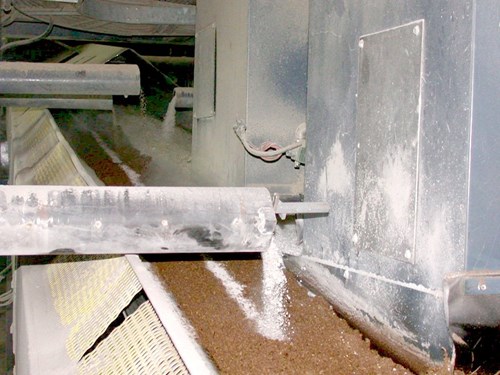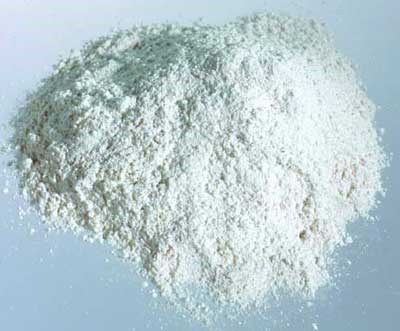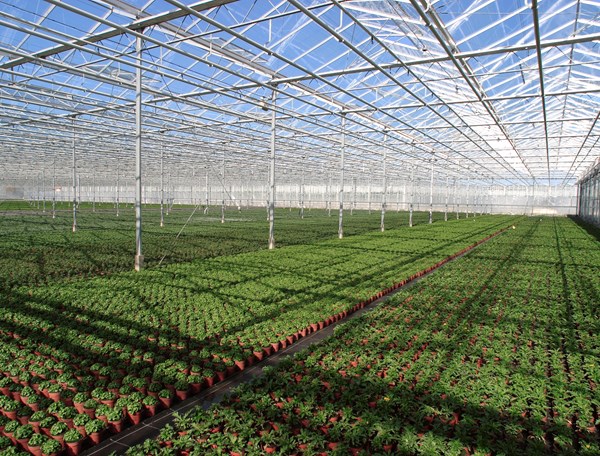Training Center
Function of Limestone in Growing Media
Thursday, September 7, 2023 | Ed Bloodnick
Limestone is commonly used in the manufacturing of growing media. It is mostly added to offset the acidity of components such as peat moss and pine bark, and to bring a growing medium's pH up into the 5.5-6.5 range, which is ideal for most crops.
Greenhouse growers know that in order to achieve optimum nutrient availability for plant growth, the growing medium's pH for most crops should be in the 5.5-6.5 pH range. The standard base components in most soilless media, peat moss and composted pine bark, have a pH in the range of 3.5-5.0.
This is too low for most crops and requires the use of limestone to bring the growing medium's pH up into the ideal range.
Many factors have an influence over the growing medium's pH
The quantity and choice of limestone used to increase the growing medium's pH is a function of several factors, including:
- the growing medium's components;
- the type of limestone;
- the particle size of the limestone used.
When the growing medium is in use, the alkalinity of the irrigation water as well as the specific crop grown will also affect the growing medium's pH; therefore, the pH must be monitored by the grower. A soilless media manufacturer only has control of the starting pH and some short-term pH stability based on the limestone source used.

Most growing media have limestone added to increase the pH of acidic components such as peat moss and bark. Source: Premier Tech
pH adjustment takes time
In general, growing media manufacturers add limestone at a rate which will provide a starting pH of 5.5-6.5. However, limestone is a granular form and must dissolve in the growing medium before the pH is stabilized and a true measurement of the pH can be determined.
There is some initial pH increase immediately following limestone incorporation (called limestone reactivity), but the long-term residual effect must be considered when determining the type and application rate of limestone for optimum growing medium pH throughout a crop cycle.
Accurate pH measurement after 7-10 Days
It is not unusual for a fresh made growing medium to have a low pH of 4.5-4.9, because the limestone has not dissolved due to the low moisture content of the growing medium's components. Depending on the moisture content, freshly made growing media may take a week to two months for the pH to rise to the normal range and stabilize. Therefore, in-use growing medium pH measurements are most accurate 7-10 days after planting and initial watering-in of the crop.
Although it takes time for limestone to react, there are other factors that determine how much limestone to add to a growing medium.
Particle size and hardness
The finer and softer the limestone particles are, the faster they will dissolve and impact the growing medium's pH. Conversely, the larger and harder the particles, the slower they will dissolve.
While there are general rules of thumb on the amount of limestone required to reach an optimum growing medium pH, growers mixing their own growing media will need to find a supplier of consistent high quality limestone, and through trial and error determine the ideal rates for their conditions and crop.
Type of limestone
The two most common forms of limestone incorporated into soilless media are calcitic and dolomitic limestone.
- Calcitic limestone is calcium carbonate and serves two purposes in the medium. First, it reacts fairly quickly to neutralize acids in the growing medium. Since it is a soft limestone, it has a short residual life. Second, calcitic limestone provides some calcium, but very little in the way of additional elements.
- Dolomitic limestone is a combination of calcium carbonate and magnesium carbonate. It also neutralizes acids in the growing medium, but in general is a harder limestone and dissolves slowly in the growing medium, resulting in longer term pH stability. Dolomitic limestone also provides some calcium and a little magnesium.

Dolomitic limestone is commonly used in the manufacturing of growing media. Source: Premier Tech
A Combination of calcitic and dolomitic limestone
Most commercial soilless growing media manufacturers rely solely on dolomitic limestone and vary the particle size to control release rates. Premier Tech Horticulture, however, uses a combination of calcitic and dolomitic limestone.
Calcitic and dolomitic limestone applications create an even and consistent growing medium pH. When using both forms of limestone, a better control of the pH can be achieved; the calcitic limestone quickly releases and stabilizes the growing medium's pH while the dolomitic limestone slowly releases over the course of the crop, which results in a pH level that is relatively stable through the crop cycle.
For more information, feel free to contact your Premier Tech Grower Services Representative.
 |
 |
 |
 |
|---|---|---|---|
|
Ed Bloodnick |
Nathan Wallace-Springer |
Lance Lawson |
Victor Brantly |
 |
 |
 |
|
|
Troy Buechel |
Susan Parent |
Jose Chen Lopez |
PRO-MIX® is a registered trademark of PREMIER HORTICULTURE Ltd.
Related Articles
-
Calcitic vs Dolomitic Limestone
Greenhouse growers know that in order to achieve optimum nutrient availability for plant growth, the growing medium pH should be within 5.5-6.2, depending on the crops grown.
-
10 Must-Know Growing Media Facts
When potting in a greenhouse, the growing media used can have a major influence on crops. There are some common questions or issues growers have concerning their soil. Here is a summary of 10 must-know regarding growing media in the industry.

 Where to find our products
Where to find our products



